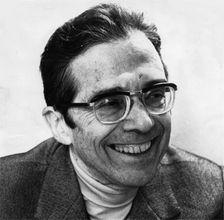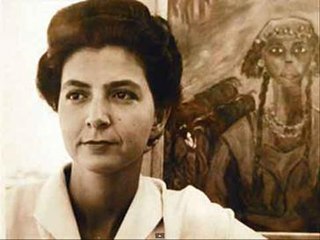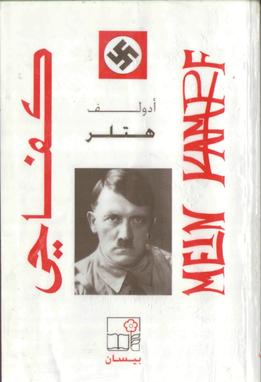Related Research Articles

Henri Curiel was a left-wing political activist in Egypt and France. Born in Egypt, Curiel led the communist Democratic Movement for National Liberation until he was expelled from the country in 1950.
The Democratic Movement for National Liberation was a communist organization in Egypt from 1947 to 1955. HADITU was led by Henri Curiel. The movement followed the line of the National Democratic Revolution.
Abdel Hadi Al Gazzar (1925–1966) was an Egyptian painter. He occupies a unique position among the artists of his generation. His membership in the Contemporary Art Group elevated his status as an artist through his utilization of social commentary in addition to the group's focus on traditional, Egyptian identity. This commentary is most widely recognized in his painting, The High Dam, in which he comments on the effects of modernization by the Egyptian government on society and their way of life. Since his death, his work has not ceased to challenge artists, intellectuals and critics both in Egypt and abroad.

Inji Aflatoun was an Egyptian painter and activist in the women's movement. She was a "leading spokeswoman for the Marxist-progressive-nationalist-feminist movement in the late 1940s and 1950s", as well as a "pioneer of modern Egyptian art" and "one of the important Egyptian visual artists".

Ida Kar was a photographer active mainly in London after 1945. She took many black-and-white portraits of artists and writers. Her solo show of photographs at the Whitechapel Gallery in 1960 was the first of its kind to be held in a major public gallery in London. Kar thus made a significant contribution to the recognition of photography as a form of fine art.
The Unified Egyptian Communist Party was a political party in Egypt. The party was founded in February 1955 through the merger of the Democratic Movement for National Liberation (HADITU) and six splinter organizations. The talks regarding the merger were held without the HADITU leader Henri Curiel being aware of them. Once the merger was finalized Curiel and HADITU leader Kamal Abd al-Halim were excluded from membership in the new party. Curiel and Abd al-Halim were allowed to enter the party in 1956, and after the 1956 war Curiel was included in its Central Committee.

Mein Kampf, Adolf Hitler's 900-page autobiography outlining his political views, has been translated into Arabic a number of times since the early 1930s.

Georges Henein (1914–1973) was an Egyptian poet and author. He was a founding member of the Cairo-based, surrealist Art and Liberty Group which brought together artists, writers and various intellectuals of different backgrounds and national origins under the shared cause of anti-fascist activism. The group was active from 1938 up until the late 1940s.
Ramses Younan, was an Egyptian painter and writer. His work is most commonly associated with the Art and Liberty Group, a Cairo-based surrealist collective of artists, writers, intellectuals and activists with an anti-nationalist message.
Étienne Sved (1914-1996) was Hungarian-born French-naturalised photographer and poster artist.
Ahmad Hasan al-Zayyat was an influential Egyptian political writer and intellectual who established the Egyptian literary magazine Arrissalah, which is described as "the most important intellectual weekly in 1930s Egypt and the Arab world." Born in the village of Kafr Demira, Talkha, into what was then a peasant family, al-Zayyat studied at Al-Azhar University before taking up legal studies in Cairo and Paris. He taught Arabic literature at American University in Cairo, and for three years in Baghdad, before founding Arrissalah in 1933. In the 1960s he served as the editor of Majallat Al Azhar, monthly publication of Al Azhar University.

Groupe Art et Liberté was an Egyptian artistic and political movement active from 1938 to 1948, about the time of the Second World War. Among the founders was the Surrealist poet Georges Henein; the group was based mostly but not exclusively on Surrealism.

Arrissalah was an Arabic weekly cultural magazine for literature, science, and art published in Cairo from 1933 to 1953. It has been described as "the most important intellectual weekly in the 1930s Egypt and the Arab world."
Kamel el-Telmissany (1915-1972) was an Egyptian artist and filmmaker most commonly associated with the Cairo-based Art et Liberté Group. He was one of the group's founding members along with Georges Henein and Ramses Younan. His nephew is the famed Egyptian cinematographer Tarek el-Telmissany.
Raoul Curiel was a French archaeologist, egyptologist and orientalist.
Ikbal El Alaily also known as Iqbal El Alaily, was an Egyptian surrealist writer, and a co-founder of the journal, La Part du Sable. She was associated with the Art et Liberté art group.
Al Tatawwur was an Arabic language literary and cultural magazine published in Egypt in the period January–July 1940. It was the first avant-garde, surrealist and Marxist-libertarian publication in the Arab world.
Omdurman was a communist publication issued from Cairo 1945-1946, directed towards Sudanese community in Egypt. The group of Sudanese communists that worked around the journal would later return to Sudan and build the Sudanese Communist Party.
London Bulletin was a monthly avant-garde art magazine which was affiliated with the London Gallery between April 1938 and June 1940. It was one of the most significant surrealist publications.
Khadiga Riad, was an Egyptian painter, sculptor, and jewelry designer. She was the first Egyptian woman to exhibit abstract artwork, and was associated with the surrealist movement. Riad has many variations in the spelling of her name in English, including Khadija Riyad, and Khadiga Riaz.
References
- 1 2 3 4 Don LaCoss (Spring 2010). "Egyptian Surrealism and "Degenerate Art" in 1939?". The Arab Studies Journal. 18 (1): 105. JSTOR 27934079.
- 1 2 3 Evelyne M. Bornier (1999). Georges Henein, Poete Des Marges (PhD thesis) (in French). Louisiana State University. pp. 42, 120. ISBN 9780599474321.
- 1 2 Sam Bardaouil (2013). ""Dirty Dark Loud and Hysteric": The London and Paris Surrealist Exhibitions of the 1930s and the Exhibition Practices of the Art and Liberty Group in Cairo". Dada/Surrealism. 19 (1): 1–24. doi: 10.17077/0084-9537.1273 .
- ↑ David Renton (2013). Dissident Marxism: Past Voices for Present Times. London: Zed Books. p. 71. ISBN 978-1-84813-650-2.
- 1 2 Rami Ginat (2014). "The Rise of Homemade Egyptian Communism: A Response to the Challenge Posed by Fascism and Nazism?". In Israel Gershoni (ed.). Arab Responses to Fascism and Nazism: Attraction and Repulsion. Austin, TX: University of Texas Press. p. 202. doi:10.7560/757455. ISBN 978-1477307571.